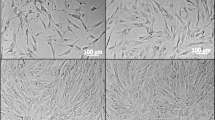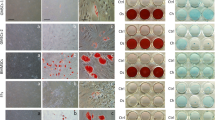Abstract
Dental stem cells from human exfoliated deciduous teeth (SHED) and dental follicle cells (DFCs) are neural crest-derived stem cells from human dental tissues. Interestingly, SHED and DFCs can successfully differentiate into neuron-like cells. We hypothesized that SHED and DFCs have the same neural cell differentiation potentials. To evaluate neural cell differentiation, we cultivated SHED and DFCs in four different serum-replacement media (SRMs) and analyzed cell morphology, cell proliferation, and gene expression patterns before and after differentiation. In a standard cell culture medium, SHED and DFCs have not only similar cell morphologies, but they also have similar gene expression patterns for known stem cell markers. However, only SHED expressed the neural stem cell marker Pax6. After cultivation in SRMs, cell proliferations of DFCs and SHED were reduced and the cell morphology was spindle-like with long processes. However, differentiated DFCs and SHED had different neural cell marker expression patterns. For example, gene expression of the late neural cell marker microtubule-associated protein 2 was upregulated in DFCs and downregulated in SHED in SRM with the B27 supplement. In contrast, SHED formed neurosphere-like cell clusters in SRM with the B27 supplement, epidermal growth factor, and fibroblast growth factor-2. Moreover, SHED differentially expressed the glial cell marker glial fibrillary acidic protein, which in contrast was weakly or not expressed in DFCs. In conclusion, SHED and DFCs have different neural differentiation potentials under the same cell culture conditions.




Similar content being viewed by others
References
Morsczeck C, Götz W, Schierholz J, Zeilhofer F, Kühn U, Möhl C, Sippel C, Hoffmann KH (2005) Isolation of precursor cells (PCs) from human dental follicle of wisdom teeth. Matrix Biol 24:155–165
Morsczeck C, Moehl C, Götz W, Heredia A, Schaffer T, Eckstein N, Sippel C, Hoffmann K (2005) In vitro differentiation of human dental follicle cells with dexamethasone and insulin. Cell Biol Int 29:567–575
Kemoun P, Laurencin-Dalicieux S, Rue J, Farges J, Gennero I, Conte-Auriol F, Briand-Mesange F, Gadelorge M, Arzate H, Narayanan A, Brunel G, Salles J (2007) Human dental follicle cells acquire cementoblast features under stimulation by BMP-2/-7 and enamel matrix derivatives (EMD) in vitro. Cell Tissue Res 329:283–294
Völlner F, Ernst W, Driemel O, Morsczeck C (2009) A two-step strategy for neuronal differentiation in vitro of human dental follicle cells. Differentiation 77:433–441
Seo B, Miura M, Gronthos S, Bartold P, Batouli S, Brahim J, Young M, Robey P, Wang C, Shi S (2004) Investigation of multipotent postnatal stem cells from human periodontal ligament. Lancet 364:149–155
Widera D, Grimm W, Moebius J, Mikenberg I, Piechaczek C, Gassmann G, Wolff N, Thevenod F, Kaltschmidt C, Kaltschmidt B (2007) Highly efficient neural differentiation of human somatic stem cells, isolated by minimally invasive periodontal surgery. Stem Cells Dev 16:447–460
Miura M, Gronthos S, Zhao M, Lu B, Fisher L, Robey P, Shi S (2003) SHED: stem cells from human exfoliated deciduous teeth. Proc Natl Acad Sci U S A 100:5807–5812
Winer J, Jung C, Shackel I, Williams P (1999) Development and validation of real-time quantitative reverse transcriptase-polymerase chain reaction for monitoring gene expression in cardiac myocytes in vitro. Anal Biochem 270:41–49
Kawanabe N, Murakami K, Takano-Yamamoto T (2006) The presence of ABCG2-dependent side population cells in human periodontal ligaments. Biochem Biophys Res Commun 344:1278–1283
Pesce M, Scholer H (2000) Oct-4: control of totipotency and germline determination. Mol Reprod Dev 55:452–457
Bylund M, Andersson E, Novitch B, Muhr J (2003) Vertebrate neurogenesis is counteracted by Sox1–3 activity. Nat Neurosci 6:1162–1168
Chen Y, Teng F, Tang B (2006) Coaxing bone marrow stromal mesenchymal stem cells towards neuronal differentiation: progress and uncertainties. Cell Mol Life Sci 63:1649–1657
Hermann A, Gastl R, Liebau S, Popa M, Fiedler J, Boehm B, Maisel M, Lerche H, Schwarz J, Brenner R, Storch A (2004) Efficient generation of neural stem cell-like cells from adult human bone marrow stromal cells. J Cell Sci 117:4411–4422
Hermann A, Liebau S, Gastl R, Fickert S, Habisch H, Fiedler J, Schwarz J, Brenner R, Storch A (2006) Comparative analysis of neuroectodermal differentiation capacity of human bone marrow stromal cells using various conversion protocols. J Neurosci Res 83:1502–1514
Shih I (1999) The role of CD146 (Mel-CAM) in biology and pathology. J Pathol 189:4–11
Kerkis I, Kerkis A, Dozortsev D, Stukart-Parsons G, Gomes Massironi S, Pereira L, Caplan A, Cerruti H (2006) Isolation and characterization of a population of immature dental pulp stem cells expressing OCT-4 and other embryonic stem cell markers. Cells Tissues Organs 184:105–116
Krabbe C, Zimmer J, Meyer M (2005) Neural transdifferentiation of mesenchymal stem cells—a critical review. APMIS 113:831–844
Woodbury D, Schwarz E, Prockop D, Black I (2000) Adult rat and human bone marrow stromal cells differentiate into neurons. J Neurosci Res 61:364–370
Woodbury D, Reynolds K, Black I (2002) Adult bone marrow stromal stem cells express germline, ectodermal, endodermal, and mesodermal genes prior to neurogenesis. J Neurosci Res 69:908–917
Corti S, Locatelli F, Strazzer S, Guglieri M, Comi G (2003) Neuronal generation from somatic stem cells: current knowledge and perspectives on the treatment of acquired and degenerative central nervous system disorders. Curr Gene Ther 3:247–272
Tondreau T, Lagneaux L, Dejeneffe M, Massy M, Mortier C, Delforge A, Bron D (2004) Bone marrow-derived mesenchymal stem cells already express specific neural proteins before any differentiation. Differentiation 72:319–326
Corti S, Locatelli F, Papadimitriou D, Strazzer S, Comi G (2004) Somatic stem cell research for neural repair: current evidence and emerging perspectives. J Cell Mol Med 8:329–337
Lei Z, Yongda L, Jun M, Yingyu S, Shaoju Z, Xinwen Z, Mingxue Z (2007) Culture and neural differentiation of rat bone marrow mesenchymal stem cells in vitro. Cell Biol Int 31:916–923
Locatelli F, Corti S, Donadoni C, Guglieri M, Capra F, Strazzer S, Salani S, Del BR, Fortunato F, Bordoni A, Comi G (2003) Neuronal differentiation of murine bone marrow Thy-1- and Sca-1-positive cells. J Hematother Stem Cell Res 12:727–734
Campos L (2004) Neurospheres: insights into neural stem cell biology. J Neurosci Res 78:761–769
Peirson S, Butler J, Foster R (2003) Experimental validation of novel and conventional approaches to quantitative real-time PCR data analysis. Nucleic Acids Res e31:e73
Osumi N, Hirota A, Ohuchi H, Nakafuku M, Iimura T, Kuratani S, Fujiwara M, Noji S, Eto K (1997) Pax-6 is involved in the specification of hindbrain motor neuron subtype. Development 124:2961–2972
Acknowledgement
This work was supported by the International Team of Implantation (ITI) Foundation. We thank Dr. S. Shi (University of Los Angeles, USA) for providing SHED. The antibodies STRO-1 and bTAN 20 (Notch-1) were obtained from the Developmental Studies Hybridoma Bank developed under the auspices of the NICHD and maintained by the Department of Biological Sciences, University of Iowa, Iowa City, IA, 52242, USA.
Conflicts of interest
The authors declare that they have no conflicts of interest.
Author information
Authors and Affiliations
Corresponding author
Rights and permissions
About this article
Cite this article
Morsczeck, C., Völlner, F., Saugspier, M. et al. Comparison of human dental follicle cells (DFCs) and stem cells from human exfoliated deciduous teeth (SHED) after neural differentiation in vitro. Clin Oral Invest 14, 433–440 (2010). https://doi.org/10.1007/s00784-009-0310-4
Received:
Accepted:
Published:
Issue Date:
DOI: https://doi.org/10.1007/s00784-009-0310-4




